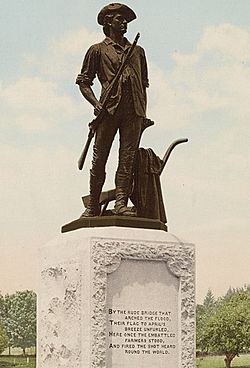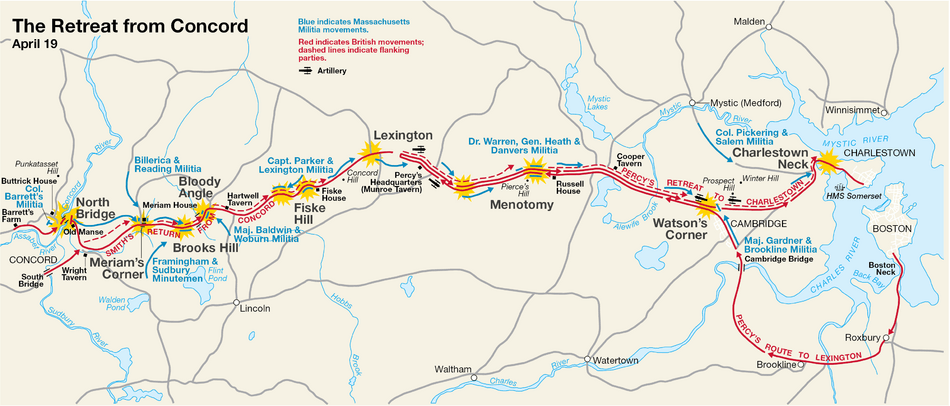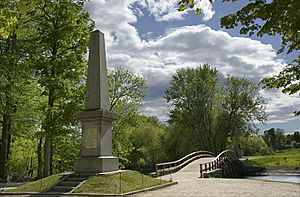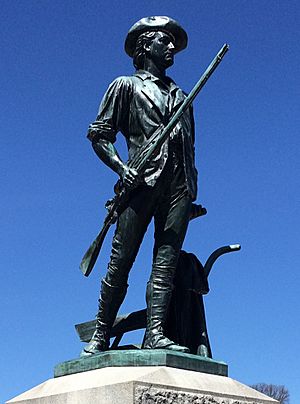The Minute Man facts for kids
 |
|
| Coordinates | 42°28′8.1″N 71°21′4.6″W / 42.468917°N 71.351278°W |
|---|---|
| Location | Minute Man National Historical Park, Concord, Massachusetts |
| Designer | Daniel Chester French (sculptor) James Elliot Cabot (architect) |
| Material | Bronze (sculpture) Granite (pedestal) |
| Height | 7 feet (2.1 m) |
| Opening date | 1875 |
The Minute Man is an 1874 sculpture by Daniel Chester French located in Minute Man National Historical Park in Concord, Massachusetts. It was created between 1871 and 1874 after extensive research, and originally intended to be made of stone. The medium was switched to bronze and it was cast from ten Civil War-era cannons appropriated by Congress.
The statue depicts a minuteman stepping away from his plow to join the patriot forces at the Battle of Concord. The young man has an overcoat thrown over his plow, and has a long gun in his hand. Nineteenth-century art historians noticed that the pose resembles the pose of the Apollo Belvedere. Until the late twentieth century it was assumed that the pose was transposed from the earlier statue. Based on Daniel Chester French's journals, modern art historians have shown that the Apollo Belvedere was only one of several statues that were used in the research for The Minute Man.
The statue was unveiled in 1875 for the centennial of the Battle of Concord. It received critical acclaim and continues to be praised by commentators. The statue has been a suffragette symbol, a symbol of the United States National Guard and Air National Guard, and has been used on coins such as the Lexington–Concord Sesquicentennial half dollar and the Massachusetts state quarter.
Contents
Background
Minutemen or Minute Companies were a part of the militia of the Province of Massachusetts Bay. The name minutemen comes from the idea that they would be ready to fight with a minute's notice. The force was created in response to the Massachusetts militia's failure to respond to the Powder Alarm in September 1774. Unlike the general militia, which was made up of all able-bodied white men between 16 and 60, the two companies of minutemen were made up young volunteers who were paid one shilling, eight pence for their time drilling three times a week. The other difference between the general militia and minutemen was how officers were appointed. In the general militia officers were appointed by the governor as a political favor; officers of minutemen were elected by their peers. By February 1775, Concord, Massachusetts had 104 minutemen in two companies.
Battles of Lexington and Concord
In 1775, the Massachusetts Provincial Congress designated Concord as the stockpile for patriot cannons, gunpowder, and ammunition. In response to the growing stockpile of arms, General Thomas Gage sent spies to Concord to survey the preparations. Based on the reports from spies and instructions from Secretary of State for America William Legge, Earl of Dartmouth, Gage ordered a preemptive strike on Concord. At daybreak on April 19, 1775, six companies of grenadiers and light infantry under the command of major John Pitcairn met a group of 70 militiamen under the command of John Parker on the Lexington Common. The militiamen were alerted to the British advance by Paul Revere, William Dawes, and Samuel Prescott who traveled from Boston. It is unknown who fired the first shot of the Battle of Lexington, but after less than 30 minutes of fighting, eight militiamen were killed and nine were wounded. After dispersing the patriots, Pitcairn moved his troops on to Concord.
Based on alerts from Prescott and reports from Lexington, 150 minutemen from Concord and Lincoln mustered on the Concord Common under the command of James Barrett. After meeting the advancing British troops, the minutemen retreated to higher ground without firing a shot. Since the British troops had control of the town, they proceed to search for and destroy the stockpiled supplies. The cannon, musket balls, and flour were all rendered unusable, but the gunpowder was removed before it could be seized. While the British were searching the town, the minutemen moved to the Old North Bridge and were reinforced by militiamen from other towns. At the bridge, 400 minutemen and militiamen repelled the British advance and forced them to retreat. Many of the minutemen who participated in the Battle of Concord went home after the British retreated from the bridge. But, minutemen from other towns skirmished with the British troops during their march back to Boston.

1836 Battle monument
In 1825, the Bunker Hill Monument Association donated $500 (equivalent to $11,299 in 2019) to Concord to build a monument to the Battle of Concord. The original plan was to place the monument "near the town pump" in Concord. Due to disagreements within the town, nothing was done with the money until Ezra Ripley donated land for the monument near the Old North Bridge in 1835. After the donation, the town had Solomon Willard design a simple 25-foot-tall (7.6-meter) granite obelisk to commemorate the 60th anniversary of the Battle of Concord. The "Concord Hymn" was written by transcendentalist writer Ralph Waldo Emerson for the dedication of the monument in 1836. At the ceremony, it was sung to the tune of "Old Hundred".
To the dislike of Emerson, the obelisk stands on the bank of the river where the British stood during battle. The Minute Man was created for the centennial celebration of the battle in 1875. Unlike the earlier monument, it was to be placed on the bank where the Massachusetts militia stood.
Creation and unveiling
The monument committee for The Minute Man – which consisted of George M. Brooks, John B. More, John S. Keys, and Emerson − only considered Daniel Chester French because he was from Concord and his father, Henry F. French, was a prominent local lawyer and former judge. The statue was French's first full-size work; previously French had produced a bust of his father and one additional statue. In 1871, a year before he was formally commissioned, the committee chairman asked French to start working on the statue. Throughout the year, French sketched possible poses for the statue. That summer, French created a small clay "related figure" that was rejected by the committee. It is unknown what that statue looked like and it was not saved.
French researched The Minute Man by studying powder horns and buttons from the era. According to Harold Holzer because French was a handsome man, "there would be a line of young women outside his studio ready to show him their alleged Colonial artifacts" to help him with his research. In 1873, his second clay model of the statue was accepted by the statue committee. The same year the medium of the statue was changed from stone to bronze. The miniature version of the statue won a local art competition in September 1873, but the pose of the figure was deemed "awkwardly stiff" by critics. The pose of The Minute Man was made more natural in the enlargement process by working with models. By September 1874, the statue was completed and a plaster version of the clay statue was sent to Ames Manufacturing Works in Chicopee, Massachusetts. Because the town did not have the money to cast the statue in bronze, through a bill introduced by Ebenezer R. Hoar, the United States Congress appropriated ten Civil War-era cannons to the project. The statue was cast with the metal from guns.
The statue was unveiled on April 19, 1875 during the centennial celebration of the Battle of Concord, in a ceremony attended by Ulysses S. Grant and Ralph Waldo Emerson. French, however, left for Italy to further study sculpture in 1874 and was not in attendance. Holzer suggests that French avoided the celebration "in case the statue was panned" by contemporary critics. French's fears were unfounded and the statue was positively received by art critics and the public.
The Concord Minute Man of 1775
French was commissioned by the town of Concord in 1889 to rework The Minute Man for the Yorktown-class gunboat USS Concord. The new statue, paid for by the United States Congress, was titled The Concord Minute Man of 1775. The reworked statue cleaned up some imperfections in the face of the original statue and incorporated elements of Beaux-Arts. French made the movement of the new statue more fluid and natural. It was completed in 1890 and installed on the gunboat in 1891. A copy of the statue was also carried by the Omaha-class cruiser USS Concord in the 1940s.
Composition
Statue
The statue is 7 feet (2.1 meters) tall and depicts a minuteman at the Battle of Concord. The farmer-turned-soldier is shown trading his plow for a flintlock long gun and stepping away from his private life toward the impending battle. The sleeves of his coat and shirt are rolled up; the minuteman's overcoat is draped over the plow. A powder horn, mistakenly, sits on the man's back instead of on his hip where it can be used. His face is alert while his eyes are transfixed on the battle that he is ready to march into.
The pose of the soldier has been compared to the pose of the Apollo Belvedere. Nineteenth and twentieth-century art critics, such as Lorado Taft and H. C. Howard, have suggested that the pose was directly copied from the Roman sculpture. Howard in particular trivializes the sculpture as "little more than an Americanized rendition of the Apollo Belvedere". Modern scholarship, working with French's journals, disagrees that the pose is a copy while acknowledging that French used a variety of plaster casts of classical sculptures, including the Apollo Belvedere, as inspiration when creating The Minute Man.
Pedestal
The Minute Man was intended to be placed on a local boulder by the town of Concord. At the instance of French and his father, the town allowed for the design of a stone pedestal. Several architects submitted designs to the town, including French's brother, but the competition was won by James Elliot Cabot. The resulting design is a simple granite pedestal that is 7.5 feet (2.3 meters) tall and 4.5 feet (1.4 meters) wide with inscriptions in two sides. On the front, it is inscribed with the first stanza of Ralph Waldo Emerson's "Concord Hymn". Cabot's design is nearly identical to French's final pedestal design. Throughout the creation of The Minute Man, French sketched and built a variety of potential pedestals.
Beneath the pedestal is a copper time capsule from 1875 that contains items from past celebrations of the battle, maps, and photographs of both the sculpture and sculptor. In 1975, a second time capsule was placed beneath the pedestal that included Girl Scouts USA pins, the United States Bicentennial's flag, and a cassette tape.
See also
 In Spanish: The Minute Man para niños
In Spanish: The Minute Man para niños



